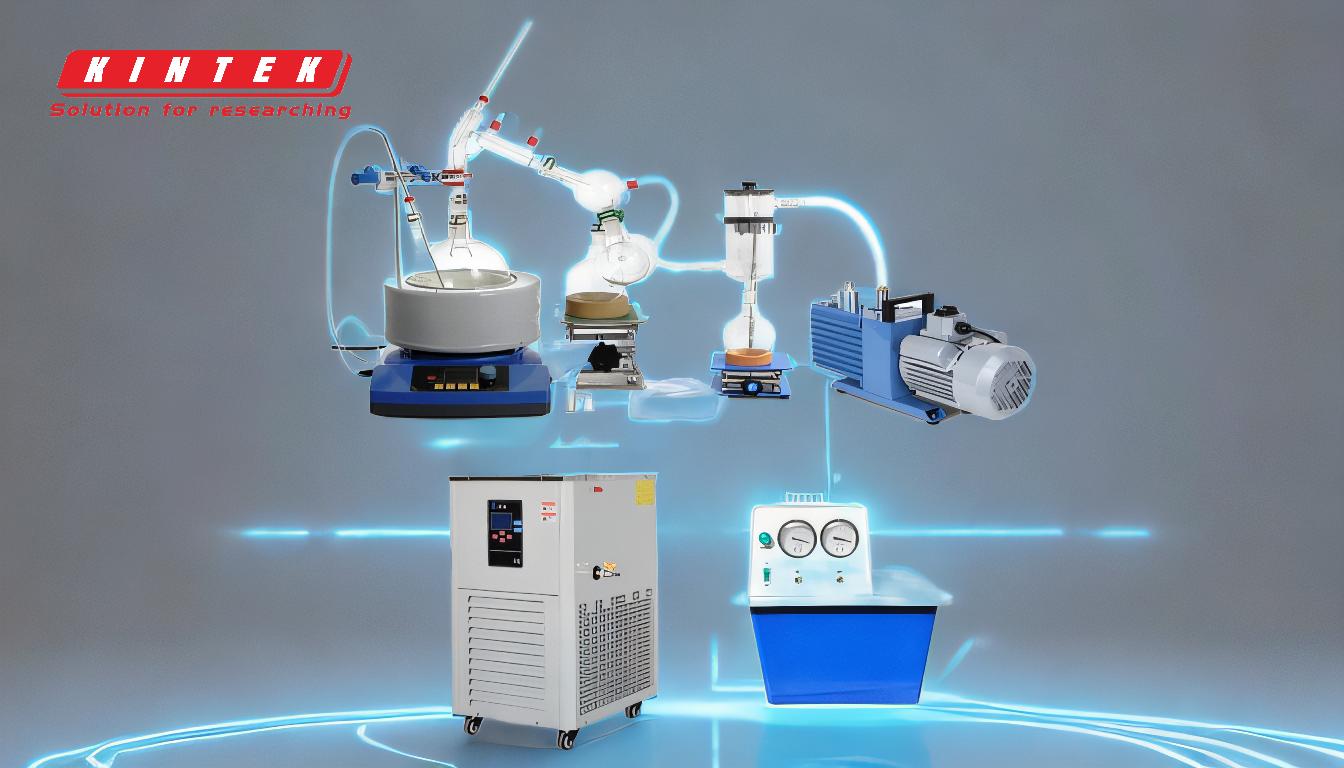Distillation is a fundamental separation technique used to isolate components of a liquid mixture based on their differing boiling points. The process involves heating the mixture to vaporize the more volatile components, condensing the vapor back into liquid form, and collecting the separated components. The key stages of distillation include preparation, heating, vaporization, condensation, and collection. Each stage requires careful control of temperature, pressure, and stirring to ensure efficient separation. Proper setup, monitoring, and shutdown are critical to achieving the desired results and ensuring safety throughout the process.
Key Points Explained:

-
Preparation Stage
- Ensure all equipment connections are secure and components are in working order.
- If using insulation, wrap the boiling flask and the bottom quarter of the distillation head, leaving the Vigreux column visible for observation.
- Close the valve on the manifold to prepare for airflow control.
- This stage is crucial for setting up the system to operate safely and efficiently.
-
Heating and Initial Stirring
- Begin heating the mixture to a controlled temperature (e.g., 60°C) and set the stirring speed (e.g., 200 RPM).
- For analog heating mantles, set the heating knob to the middle position and maintain this temperature.
- If no reaction occurs, slightly increase the temperature to initiate vaporization.
- Proper heating and stirring ensure uniform temperature distribution and prevent localized overheating.
-
Vaporization and Separation
- As the mixture heats, the component with the lower boiling point vaporizes first.
- The vapor rises through the distillation head, where it is directed toward the condenser.
- This stage relies on the differences in boiling points to separate the components effectively.
-
Condensation
- The vapor passes through a condenser, where it is cooled and converted back into liquid form.
- The condenser is typically cooled by a circulating coolant (e.g., water) to facilitate rapid condensation.
- This step ensures the vapor is collected as a purified liquid.
-
Collection
- The condensed liquid (distillate) is collected in a receiving flask.
- The distillate should be monitored to ensure it contains the desired component.
- Collection continues until the desired volume or purity is achieved.
-
Adjustments During Distillation
- As the fluid level in the boiling flask decreases, increase the stirring speed (e.g., 900-1000+ RPM) to maintain efficient heat transfer.
- If the reaction subsides, increase the temperature by an additional 10°C to sustain vaporization.
- These adjustments help maintain the separation process as the mixture composition changes.
-
Shutdown and System Venting
- Once the reaction stops and no more distillate flows, turn off the heat, stirrer, and vacuum pump.
- Open the valve to allow atmospheric pressure to equalize within the system.
- Proper shutdown prevents pressure buildup and ensures safe handling of the equipment.
-
Importance of Monitoring and Control
- Throughout the process, monitor the temperature, stirring speed, and distillate flow rate.
- Adjust parameters as needed to optimize separation and prevent overheating or system failure.
- Effective monitoring ensures the process runs smoothly and yields high-quality results.
By following these key stages, distillation can effectively separate and purify components from a mixture. Each stage requires careful attention to detail and precise control of operational parameters to achieve the desired outcome.
Summary Table:
| Stage | Key Actions | Purpose |
|---|---|---|
| Preparation | Secure equipment, wrap insulation, close manifold valve. | Ensure safe and efficient system setup. |
| Heating & Stirring | Heat to controlled temperature (e.g., 60°C), set stirring speed (e.g., 200 RPM). | Achieve uniform temperature distribution and prevent overheating. |
| Vaporization | Heat mixture to vaporize lower boiling point components. | Separate components based on boiling points. |
| Condensation | Cool vapor in condenser using coolant (e.g., water). | Convert vapor back into purified liquid. |
| Collection | Collect distillate in receiving flask, monitor for desired component. | Obtain purified liquid with desired volume or purity. |
| Adjustments | Increase stirring speed (e.g., 900-1000+ RPM) and temperature as needed. | Maintain efficient heat transfer and separation as mixture composition changes. |
| Shutdown & Venting | Turn off heat, stirrer, and vacuum pump; open valve to equalize pressure. | Prevent pressure buildup and ensure safe handling. |
| Monitoring & Control | Monitor temperature, stirring speed, and distillate flow rate. | Optimize separation and prevent system failure. |
Need expert guidance for your distillation process? Contact us today to ensure optimal results!









